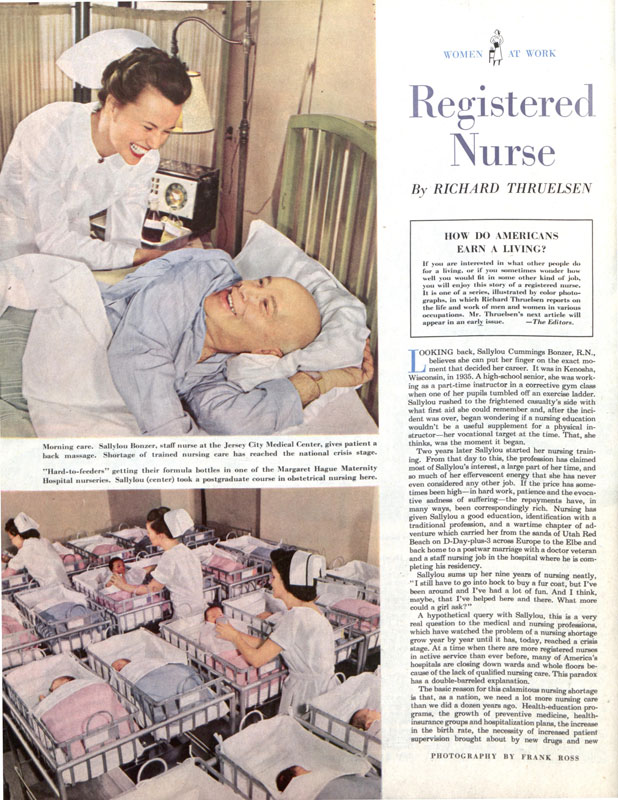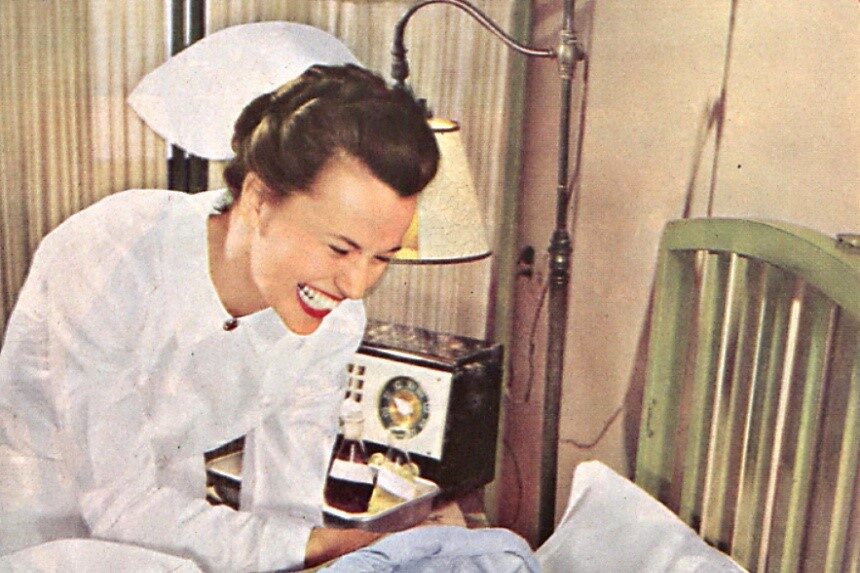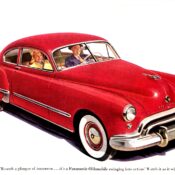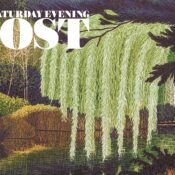In the 1940s, The Saturday Evening Post started a series called “Women at Work,” where it profiled careers available to women at the time, such as teacher, secretary, and stewardess. In their April 3, 1948, issue, they focused on Sallylou Cummings Bonzer’s path to becoming a registered nurse.
Being a working woman has always had its challenges, and those challenges were certainly more stark in the years surrounding World War II.
More preventive care, more babies, more veterans, and more complex medical interventions had all led to a spike in the demand for nurses at a time when the nurse’s average wage for a 44-hour week was $40 ($500 a week in today’s dollars).
In 1948, at least schooling was relatively cheap. Sallylou’s tuition at St. Luke’s Hospital in Racine, Wisconsin was $25; room, board, and laundry included. Tasks for newly “capped” student nurses including arranging flowers and cleaning utility rooms. After earning her R.N. in October 1941, she worked as an O.R. nurse for $100 a month.
Not long after, she joined the Army Nurse Corps. After months of training, waiting, more training and more waiting, Sallylou found herself wading ashore on Utah Red Beach three days after D-Day. Except for an air-evac group, they were the first nurses to land on the beach. For days, she worked in an operating tent in a cow pasture near Ste.-Mere-Eglise: “a foggy confusion of mud, blood, uniforms and noise.”
As the war turned in the Allies’ favor, her unit worked its way across France and then deep into Germany. “V-E Day found us in Weiden, not far from the prewar Czechoslovak frontier….The Czechs were delighted to see us and we all made some good friends among the civilians.” She spent five happy months there. After shipping home, marriage, more training, and a job in New Jersey soon followed. One could fit in just find if one worked hard and followed the rules:
We can’t wear too much make-up, or colored nail polish, or rings, or colored handkerchiefs, or anything but white stockings. And we must keep our hair off the collar. And we have to look immaculate on the two uniforms the hospital launders for us each week. The average nurse needs at least four changes, which means she does the other two herself or sends them out for washing and ironing at one dollar apiece. You just can’t win, I’ve decided.
Her postwar future looked bright, however. After Sallylou’s husband finished his residency, she planned to work as his nurse for a year in private practice. After that she hoped to become a housewife.

Subscribe to the magazine for more art, inspiring stories, fiction, humor, and features from our archives.
Become a Saturday Evening Post member and enjoy unlimited access. Subscribe now




Comments
I have a connection to 2 articles in this issue.
I graduated from nursing school in 1974 and I can honestly say that I found the article very interesting. I recently retired from working as an ER nurse for 30 years. My goodness things have changed in just those 30 years. I can remember when I first started working 2 of the nurses were getting ready to retire and they sat me down and said how they envied me. They each recalled how things were when they first started many years ago, they said they can only imagine what all I will learn and see. They were so right; I can only wish they were still alive so I could tell them that I still remember that conversation and how right they were. I have passed that conversation on to my niece and grand daughter-in-law and a few other close friends.
My second connection is with my aunt who worked as a Bell Telephone operator. (She retired in 1974). I can remember as a little girl (probably around 1960) my dad would take me or my sister with him to pick her up after work, we would get buzzed into the building then after walking up 2 flights of steps we would arrive at this huge room.
There were many operators sitting at this very long console (for lack of a better word). They would pick me up and sit me on this chair that I could see eye to eye with my father. I was sitting at the (“Dummy Board”) It was used for training for new operators and for new equipment training. I was able to try to be an operator too. There was a big board with lots of cables and lights that would go on and off. All of the women had heavy headsets on and yes, they were heavy because I had tried one on too, I had to get the full affect. These were wonderful memories that I will never forget, and I know that my sister will remember getting the full experience too. I can remember later in life learning how many operators it would take to get a phone call from Pittsburgh to say California. There was an operator in each zone that would hand over the call to the next operator and reman connected until the call was ended for fear that the call would be accidentally disconnected. It would take approx. 10 operators to work that one call. The calls, because of the prices were very expensive they were almost always either joyous or sad or a business call. All were very important to both the caller and the recipient. No matter the distance the operators would listen to make sure there were 2 voices on the call to make sure it had connected.
Back then women were the main work force as operators they had a great responsibility and took their work very seriously.
Thank you so much for letting me remember many fond memories.
Fantastic article on the challenges (to put it mildly!) and rewards of being a nurse during World War II and afterwards. I read the whole thing. It’s a VERY tough job, then or now. It would be great if some current nurses would add their comments on the differences they experience now, for better and worse.
Bob Dickie, that would be great. I looked her up online, and she lived to almost 101 (1918-2019). There’s a really good feature and tribute there from the Seattle Times link mentioning this ’48 article on her. I hope someone from her family gets the Post now, enjoys the dual format of it, sees this feature and adds their comments. Sallylou exemplifies the very definition of ‘The Greatest Generation’!
Of course, now it would be great to have a follow up on Sallylou Bonzer. I’d love to know how the rest of her life turned out for her!